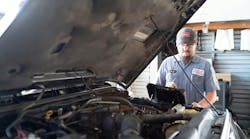Depending how old your vehicle is, the biggest reason to get a coolant flush may be under your radiator cap. When your vehicle is completely cold, try removing the radiator cap and checking your coolant level and condition. Unless you’ve recently had a cooling system flush, you most likely won’t find bright, clean coolant. You’re more likely to find particles floating in your coolant along with a brownish tint. In this article, we’ll talk about where that tint comes from, why it’s important to flush your coolant and how often to perform the flush.
The cooling system in your vehicle is made up of a few basic components. First, the purpose of your cooling system is to keep your engine cool, so the main part of your cooling system is the water jacket. The water jacket is a space around your engine block and cylinder head surrounding the cylinders and combustion chambers. The coolant flowing through your water jacket pulls heat out of your engine and transfers it to the atmosphere. This transfer happens at your vehicle’s radiator which is mounted at the front of your car to take advantage of airflow as you drive. A water pump is attached to your engine and most often driven by a belt. The water pump is what moves the coolant from your engine to your radiator so the heat can be transferred out.
Besides these main components, your cooling system also includes the hoses connecting all the large components and the thermostat which is a temperature controlled valve that keeps your engine at a constant operating temperature. Many cooling systems also include a heater core to bring warm coolant into the cabin of your vehicle to heat it, a coolant reservoir to hold coolant as it expands and your system warms up, and the radiator cap which maintains the pressure in your system.
With all these different components in your cooling system, the small particles you find in the old coolant can come from a few different places. First, your engine block is most likely made of cast iron, which can corrode over time so many of the particles in your coolant could be small bits of cast iron and rust from inside the cooling jacket. The hoses that connect all the components are made from rubber so they small pieces of this rubber can start to flake off as the hoses age. Some of the particles in your system can also be from your water pump as it wears out over time as well. The brown tint you often see is corrosion products from all the other different metals in your cooling system slowly corroding over time.
Your coolant’s main job is to draw heat out of your engine and transfer it to the environment. Your coolant’s secondary job is to make sure the components in your system corrode at a very slow rate. Cooling systems today can have copper, aluminum, cast iron, steel, and other metals present, so your coolant has a big job to do. The main purpose for flushing your coolant often is not just to remove the particles and brown tint your coolant has acquired, but also to replenish the corrosion inhibitors that have worn out or broken down in your old coolant.
Different coolants have different additives in them to inhibit corrosion based on the need of the system they are used in. The type of coolant and the additives present in your coolant will determine how often you should get a coolant flush. There are many colors of coolant to choose from and each type has a different set of corrosion inhibitors present.
The first place to check for what kind of coolant your vehicle should have installed, and therefore the coolant flush interval, is your vehicle’s owner’s manual. Even if your manual does not specify a coolant flush interval, if it recommends replacing the thermostat or water pump, it is appropriate to flush the coolant during that maintenance item.
Flushing your coolant shouldn’t just include a drain and a refill, but an actual flush. This includes draining your old coolant, flushing the system with clean water and a chemical flushing agent, then refilling it with the correct type of fresh coolant. The pure water you can simply get from your garden hose, and the chemical flushing agent you can find at your local auto parts store.
For information on BlueDevil's Radiator Flush, visit the company's product information page here: Radiator Flush.
Information provided by: Blue Devil Products


